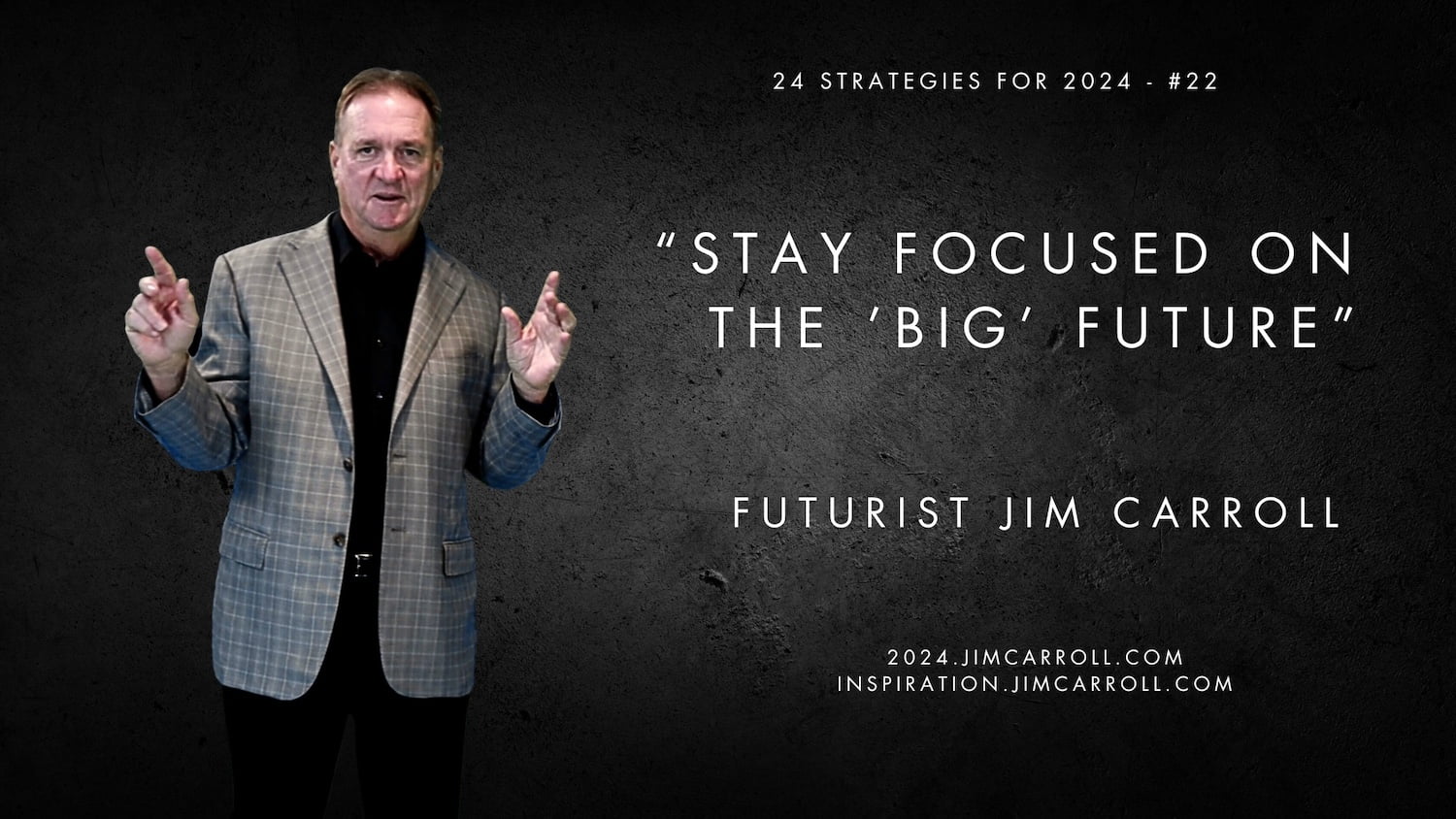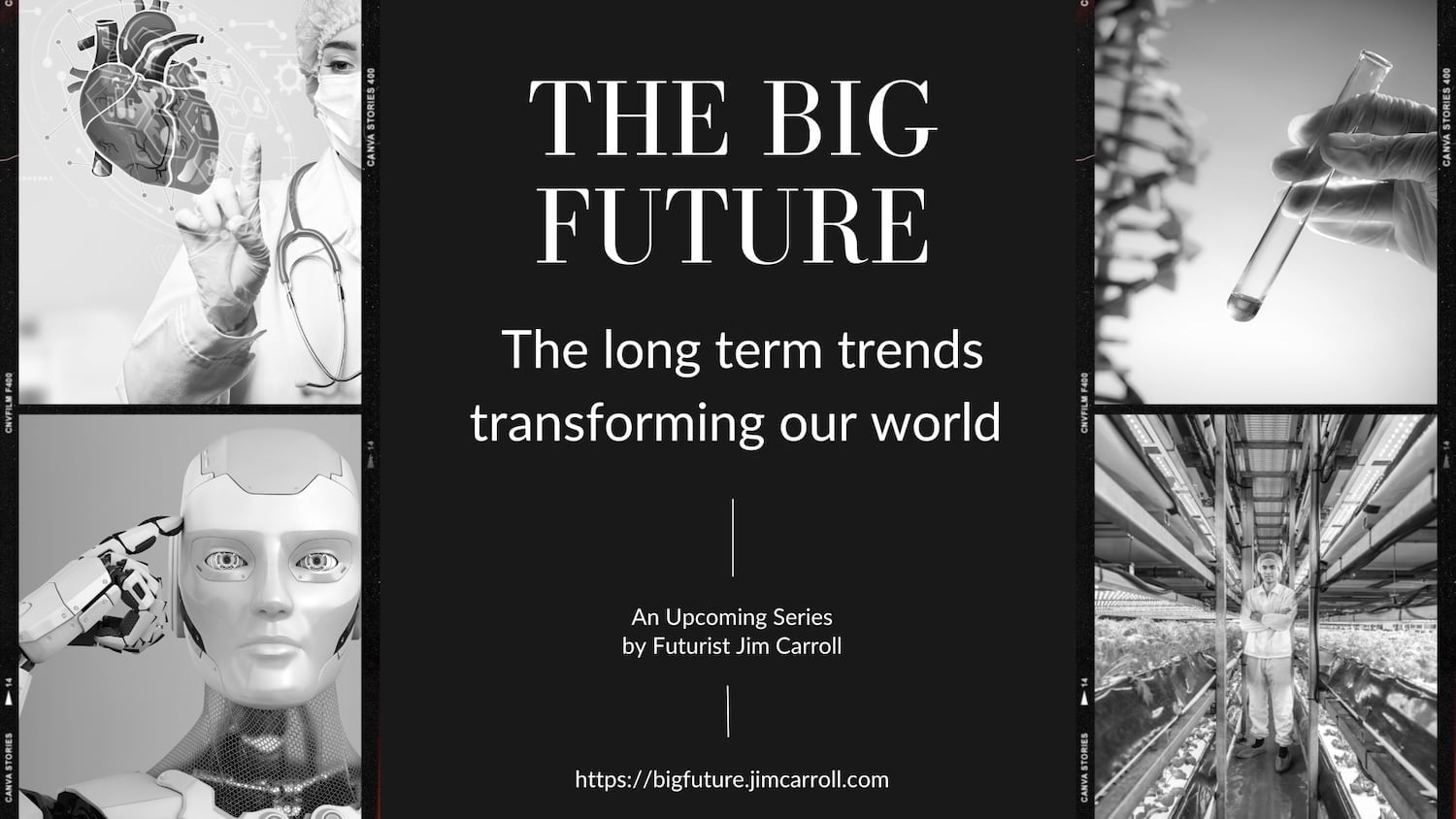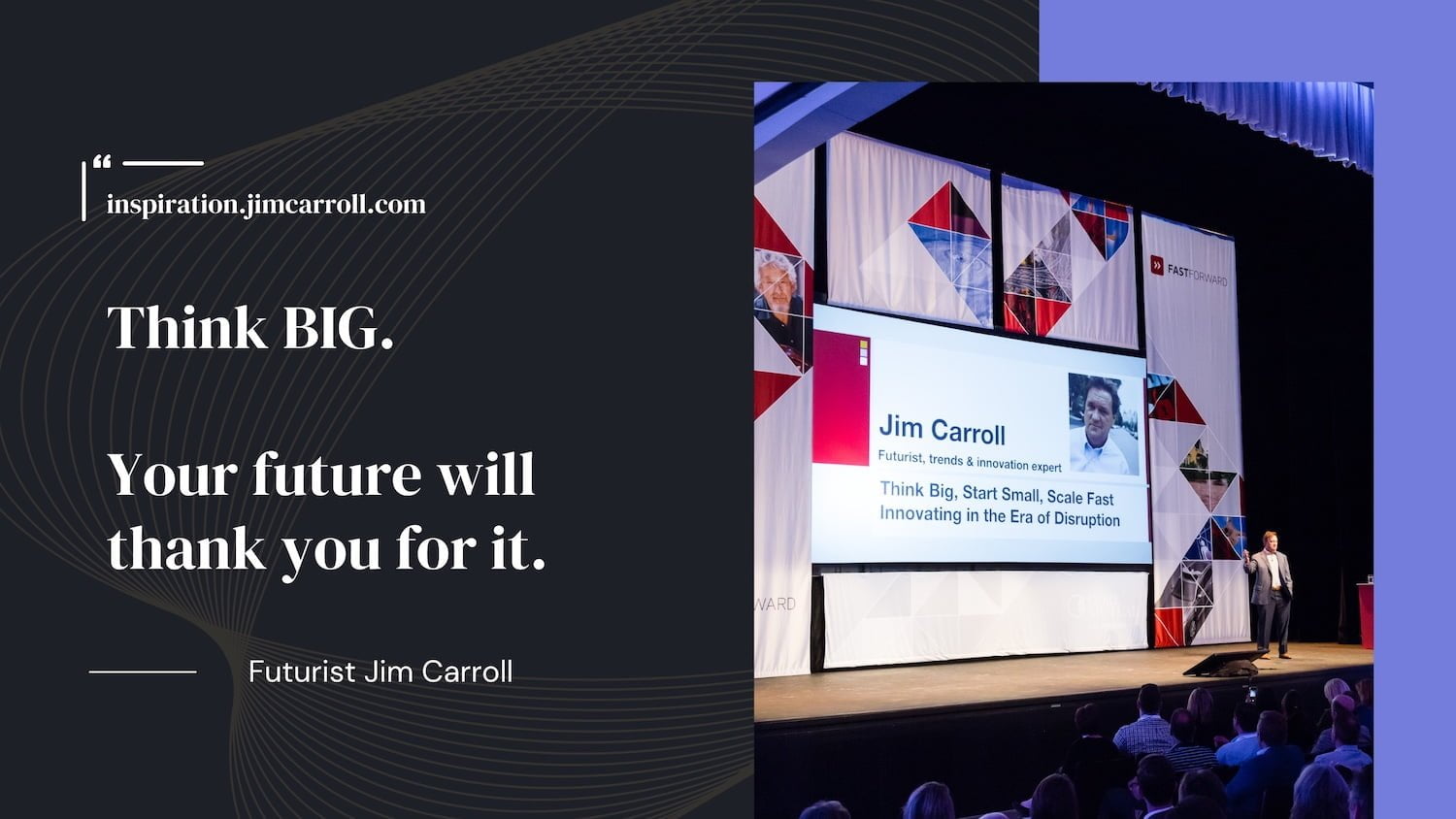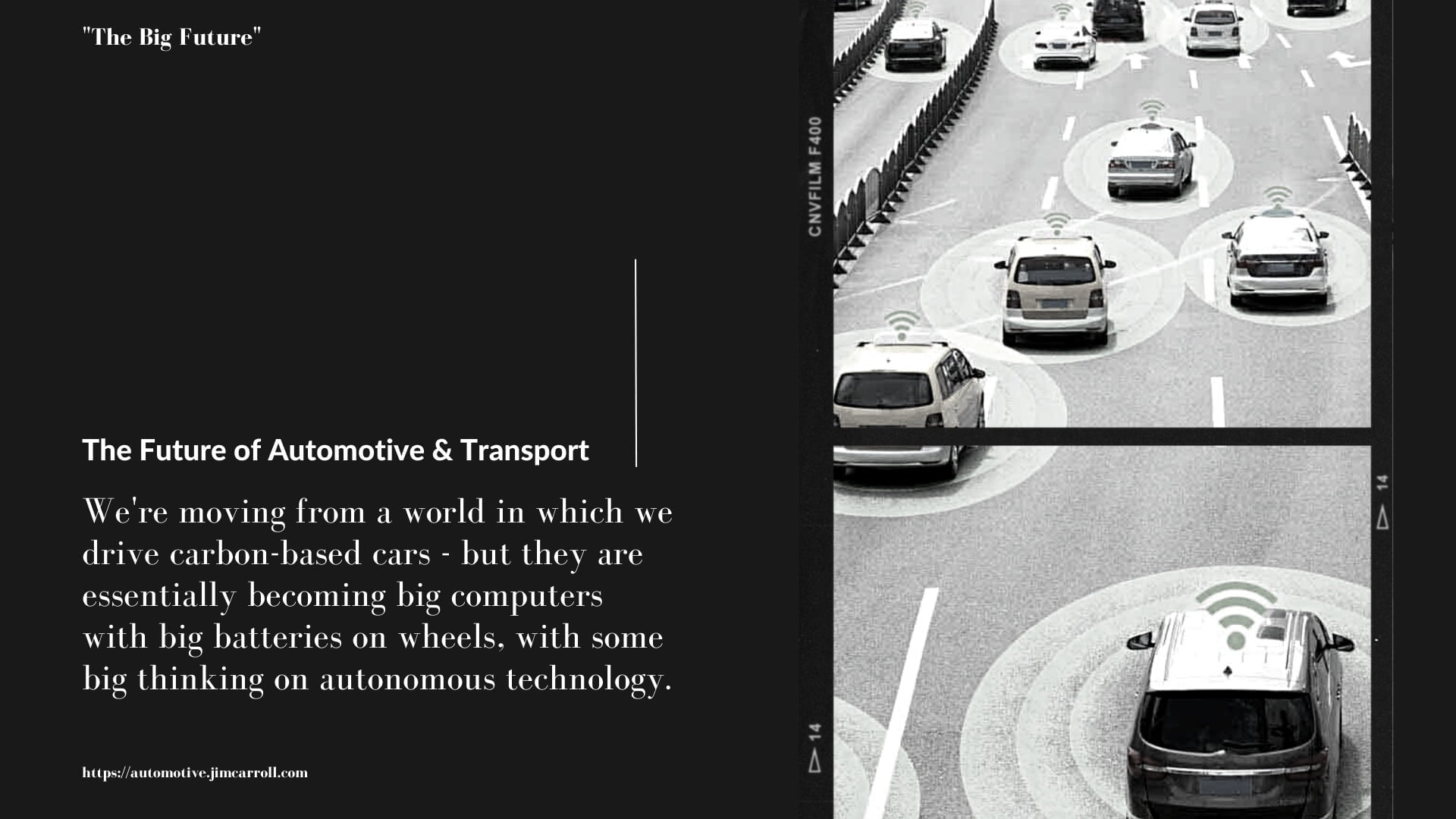“Stay focused on the ’BIG’ future” – Futurist Jim Carroll

Futurist Jim Carroll is running a series that began November 27, 2023, and will end on January 1, 2024 – ’24 Strategies for 2024.’ Rather than running a trend series for the upcoming year as he has previously, this series will examine a number of his personal beliefs on how to best align yourself with the future. There will be a post each weekday, excluding weekends and holidays, until the series runs its course. You will find it on his blog at https://blog.jimcarroll.com, or on the website https://2024.jimcarroll.com
Are you thinking about the trends that matter? Consider this statement:
When it comes to the future, it’s always important to think about a trend from a long-term perspective while acknowledging the short-term issues that occur along the way.
But as the future comes at us with greater speed and intensity, it could be that we lose sight of the long-term view of where the future is taking us as short-term issues come to dominate the discussion. With that in mind, it’s a good time to think about The BIG Future.
That’s how I open my page about what I call the BIG Future – which you can find, of course, over at https://bigfuture.jimcarroll.com.
It’s a page that I started pulling together last year when AI was becoming all the rage; my thought process was that while there was something significant happening with accelerating AI technologies, we might see everyone forget about all the other ‘stuff.’ I believed (and rightly so) that many people would commit the fundamental mistake of focusing mostly on the ‘hot’ trends (i.e. AI), and ignoring other trends that were equally, if not more, significant. My goal with my ‘BIG future’ series was to begin to pull together a group of disparate, unrelated but very significant trends that would have a big impact on us going forward, but that was often not covered in the context of everything else.

So far, I’ve covered such issues as vertical farming, the acceleration of brain science, regenerative medicine, “connected” energy, materials science, the longevity divide, and more. Each of these trends is massive in scope, significant in their potential (or risk), and involves a LOT of opportunity. If you haven’t had a look, you might want to make sure you do.
In addition to that, I’ve sprinkled throughout the page a variety of images that summarize the major, long-term transformative trends that are redefining entire industries, including healthcare, insurance, agriculture, retail, manufacturing, and others. Each of these bears a mention – and is all a part of what I do within my stage work when I am doing a deep dive into a particular industry. My overall goal? People should think BIG about the BIG transformations occurring within entire industries.

With that in mind, here’s an overview of a bit of what I believe you need to consider, with a variety of industries under the microscope. Each of these BIG trends will take years and perhaps decades to unfold but will have a profound impact. There’s more of this thinking over at another one of my trends series – trends of 2030, which you can find, of course, at https://2030.jimcarroll.com. That’s why this is Strategy #22 of my 24 Strategies for 2024 series.

Automotive and transportation? The BIG trend is that we’re moving from a world in which today, while we mostly drive carbon-based cars – tomorrow, they are essentially becoming big computers with big batteries on wheels, with some big thinking on autonomous technology (although I will admit that I have soured somewhat on the whole ‘self-driving car’ thing.) Despite the short-term noise around the electrification of vehicles, the long-term trend is such that in just over a decade, you’ll be hard-pressed to find a gasoline or diesel vehicle; and the typical vehicle will essentially be like a big iPad on wheels.

Construction? We’re moving from a world in which do much more factory-based manufacturing offsite, with rapid final assembly on-site. Add to that new methodologies and new material science based on 3d printing technology, and the entire process of construction is changing. In numerous construction and infrastructure-oriented keynotes over the last few years, I’ve pointed out that we are implementing new methodologies and new thinking to the entire process of construction, with more and more of the processes undertaken offsite, in large-scale facilities dedicated to the construction process. It’s assembly line thinking coming to the manufacturing sector.

Education? We’re moving to a world of just-in-time knowledge – getting the right knowledge at the right time for the right purpose. Education becomes less about ‘teaching specific knowledge‘ and more about how to ‘find specific knowledge.’ This is going to become particularly relevant as the era of AI is unleashed upon us, and we continue to drown in massive volumes of information. On stage, I speak about the rapid emergence of new knowledge and the fast obsolescence of existing knowledge – and the knowledge industry will increasingly focus on how to navigate this complexity.

Energy? Let’s face it – despite the political machinations at COP28, we all know that carbon is over – even the Saudis and BP and others know that. In the utility sector, the big trend is ‘connected energy‘ – we are moving a world of local energy microgrids based on renewable technologies, carefully balanced and managed through advanced AI technologies. In that context, batteries are the future of just about everything, and production is all about solar, wind, and other new forms of energy generation. Spare me the pushback – the science and economics don’t support the whining.

Food? As new science takes hold and massive urbanization takes place, we are chasing new ideas on how to produce more food with few inputs – and eat healthier. This leads to ideas like vertical farming, cellular agriculture, and customizable, programmable, AI-based, real-time food planning based on instant health assessment! The future of food is all about new ideas, rapid innovation, and bold thinking.

Healthcare, medicine, and pharmaceuticals? In essence, we’re turning the global healthcare system upside-down with precision medicine, targeted therapies, and accelerated science – fixing people before they are sick rather than after! It’s all about DNA-based medicine, connected medical devices, the virtualization of healthcare, and the rapid discovery of new science, methodologies, treatments, and forms of diagnosis.

Insurance? We’re moving from a world in which insurance risk is assessed by actuaries looking back in time, to one that involves real-time predictive risk analysis. As we extend connectivity to every device, we can underwrite insurance risk based on real-time data. We won’t do your health insurance based on a urine or blood test – but based on your current blood pressure, glycemic index, and more. The entire philosophy of insurance is undergoing a massive change, on both the life as well as the property and casualty insurance side of the industry.

Manufacturing? We’re moving from a world of mass production to one of mass customization, accelerated by digitization, and robotics. It leads to build-to-demand as opposed to building-to-inventory business models for many industries, with a LOT of highly intelligent robotics leading the way. New materials science – which I cover within my trends series – leads to the invention of all kinds of new products that can be manufactured in new and different ways.

Retail? We’re moving from a world in which we go out to get all the stuff we need, to one in which more of the stuff comes to us – accelerated, of course, by the global pandemic. The future of the industry is driven by drone technology, robotics, and advanced last-mile logistics methodologies. We will continue to see an ongoing collapse in traditional retail locations and an acceleration of everything involving home delivery – it’s all Amaon-like concepts all the time.

Last but not least? One of my favorites is agriculture. We’re moving from a world in which we only farm when the sun is up – to farming 24 hours a day, based on robotics, autonomous technology, virtualization, and more. I like to emphasize that the kid playing Farmville today is the young adult who will be managing the high-tech, autonomous virutalized farm of tomorrow!

All of these industry transformations involve massive, significant trends, many of which have already been underway for quite some time. These are not necessarily fast trends – they are slowly moving and will take years and decades to unfold. As they do, they will continue to lead to the birth of new companies, entire new sub-industries, new jobs and careers, massive new knowledge sets, and so much more. It’s by delving into and understanding these trends that you will be able to discover and shape so much of your future.
The interesting thing is that many of these trends now involve significant pushback by what I referred to in post #1 of this series – what I call the anti-future futurists. I suggested that you ignore their whining, prattle, and political efforts, because ultimately, in the face of the relentless march of tomorrow, most of their compelling will essentially go nowhere.
That’s why, throughout 2024, I would encourage you to not only keep involved with today’s hot trends (hello AI!) but also keep your eye on the BIG trends that over the long term matter. Consider what you need to do to understand them, align with them, and align your career, knowledge, and industry path toward them.
It’s only by following the first part of my mantra – “Think BIG, start small, scale fast” – that you can capitalize on tomorrow, today.




GET IN TOUCH
Jim's Facebook page
You'll find Jim's latest videos on Youtube
Mastodon. What's on Jim's mind? Check his feed!
LinkedIn - reach out to Jim for a professional connection!
Flickr! Get inspired! A massive archive of all of Jim's daily inspirational quotes!
Instagram - the home for Jim's motivational mind!